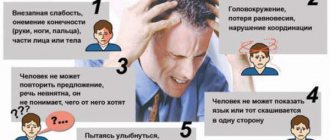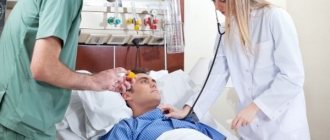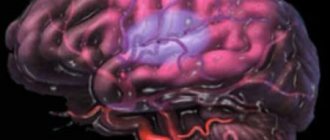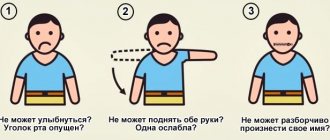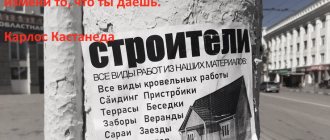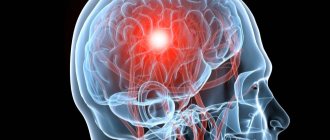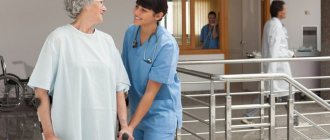Speech impairment due to stroke
Stroke can be hemorrhagic or ischemic.
With a hemorrhagic stroke, too much blood flows to the brain, and arteries may rupture, but with an ischemic stroke, on the contrary, not enough blood flows to the brain. Hemorrhagic stroke is less common, but causes more serious consequences for the patient. But in both cases, the areas of the brain responsible for speech may be damaged in a person.
If speech fails, then the disturbances occurred in the left hemisphere of the brain. With such a stroke, the right side is paralyzed and there is no speech.
Strokes with paralysis on the right side occur more often than on the left. And this is better for the patient, since in this case it is easier to make a diagnosis, since speech disorders are always manifested.
Such disorders are called aphasia. In this case, disturbances can occur in different parts of the brain. Depending on this, the consequences may be different. How to restore speech after an ischemic or hemorrhagic stroke?
Let's look at the types of aphasia and their consequences:
- Amnestic . A person can communicate, but periodically forgets the names of the objects he is talking about.
- Semantic . In this case, you need to talk to the patient exclusively in simple sentences; he simply will not understand complex ones.
- Sensory . A complex type of aphasia in which the patient does not understand speech at all. For him it comes down to a set of sounds. At the same time, he practically cannot understand the meaning of what was said.
- Motor . A person understands everything, but cannot say anything coherently, confuses sounds and words, or gets stuck on one sound combination.
- Total . The patient does not understand anything, does not recognize anyone, cannot say anything. Most often, this phase occurs immediately after a stroke. After some time, it can turn into motor.
How to treat aphasia
As everyone is taught from childhood, “nerve cells do not regenerate.” In fact, this is not entirely true: even in very old people, new connections can be formed between living neurons - “bridges” along which information will flow from the nerve cell on one side from the source of the stroke to the neuron on the other side. But for this you need:
- daily activities that will use areas of the brain located next to the dead zone;
- sufficient blood supply to the brain, especially in the affected area;
- providing the brain with the necessary amount of oxygen;
- elimination of additional chaotic impulses that arise in the brain during stress and prevent the flow of impulses from being directed to the area near the site of dead cells. Stress in aphasia is caused by the fact that a person understands his inability to convey his thoughts to others.
Aphasia after a stroke is also treated according to these principles. It needs to be started as early as possible - as soon as the swelling of the brain is stopped, which is manifested by depression of consciousness (from drowsiness to coma), convulsions, and hallucinations.
Therapy should be:
- started as early as possible;
- carried out daily, to the extent that the patient can handle;
- is aimed at correcting not only oral, but also written speech, if such a syndrome occurs in your relative.
In some cases, aphasia after a stroke can resolve on its own, but this is extremely rare, so you should not count on such an outcome. Basically, treatment of this syndrome is a long and painstaking process, requiring great dedication from relatives.
Let's look at each type of therapy in detail.
Drug treatment
It is prescribed by a neurologist at the hospital where the stroke patient is located, and begins as early as possible. Drug therapy includes drugs that improve the delivery of oxygen and nutrients to the brain, strengthen nerve connections in it, and optimize metabolism in it. This:
See also:
- Ischemic cerebral stroke: symptoms, prognosis, treatment
- Dementia stages and disease prognosis: challenges and solutions along the disease trajectory
- Microstroke: first signs and symptoms, consequences, treatment
- "Cerebrolysin" ("Semax");
- "Gliatilin" ("Holitilin", "Cereton");
- "Somazina" ("Ceraxon");
- succinic acid preparations “Cytoflavin”, “Reamberin”, “Mexidol”;
- B-group vitamins: Neuromidin, Milgamma.
These drugs are used in combination, according to the scheme that is practiced by this medical institution. Initially, they are administered intravenously and intramuscularly for 1-3 weeks. Next, they switch to the tablet form of these medications.
In addition to these medications, the patient is administered those medications that his condition requires. Therefore, if aphasia after a stroke is complemented by other, more life-threatening disorders, the complex of treatment for the speech disorder itself is “cut down” - to reduce the drug load on the internal organs.
Physiotherapy
To treat aphasia after a stroke, physiotherapeutic procedures are performed to improve cerebral circulation. This:
- acupuncture;
- electromyostimulation (exposure to current pulses) of the muscles involved in articulation;
- exposure of the cerebral cortex to a magnetic field.
Classes with a speech therapist
A special speech therapist, an aphasiologist, deals with the relief of aphasia after a stroke. Typically, these specialists work in the same medical institution that treats stroke, but in some cases, relatives have to find such a specialist on their own.
Classes with an aphasiologist should begin in the neurological department, a week after the patient is transferred from the intensive care ward. This doctor trains an older person who has had a stroke for 5-7 minutes at first, gradually increasing the training time to 15 minutes. It works like this:
- Build a dialogue with the patient.
- Seek understanding.
- Practice reading.
- Recall writing skills.
Before starting classes with a patient with sensory aphasia, if he does not understand his condition, he is asked to write a word (usually he writes a set of letters), then read it. They communicate with him through facial expressions and gestures. On a piece of paper with a set of letters, underline with a pencil or pen.
The aphasiologist must show the relatives the exercises he performs with the patient so that they can repeat them in the evening.
Examples of exercises:
- Bloating of the cheeks.
- Licking the tongue alternately between the upper and lower lips.
- Stretching your lips with a tube, after which you need to hold them in this position for 5 seconds, then relax.
- Tongue movements: to the tip of the nose - to the chin.
- Attempts to form a tube in front of a mirror.
- Move the lower jaw forward and upward to grab the upper lip with your teeth. Then do the same with the lower jaw.
- With your mouth closed, you need to try to reach the tongue with your tongue.
- Clicking the tongue against the roof of the mouth.
- Image of kisses.
- Pronunciation of simple familiar words.
With an aphasiologist, they learn a phrase or word with which to start communication, “remember” counting from 1 to 10 and in reverse order.
Melodic intonation therapy is effective in the treatment of aphasia: while singing, articulation improves and self-confidence appears. They begin singing with a familiar song, supporting the patient in every possible way, even if he could not utter a single intelligible sound.
For sensory aphasia, training with cards with pictures on them helps. You can use special computer programs (for example, a program for speech therapists by Ryabtsun) or applications on your phone. The aphasiologist asks the patient to explain what he wants to say using pictures. Also, if a person confuses letters in words, he asks to show where, for example, “barrel” is depicted and where “kidney” is depicted.
If speech is slightly affected, or at later stages of treatment, they resort to dictations and reading aloud. For treatment, it is also important to pronounce tongue twisters, especially those sounds that the patient cannot pronounce.
After each successfully completed task, the patient is praised.
In addition to exercises and dictations, a speech therapist-aphasiologist performs speech therapy massage. To do this, he carefully massages different areas of the tongue, lips, cheeks, and palate using a spatula or spoon. The purpose of the massage is to restore muscle tone in these areas in order to improve speech.
Sessions with a psychotherapist
Patients with aphasia after a stroke, especially its motor variety (when they understand speech, but cannot reproduce it), are distinguished by tearfulness and depressed mood. To prevent them from developing depression, they need sessions with a psychotherapist. This specialist will assess the mental state of your relative and, based on this, prescribe the appropriate type of psychotherapy, which can be supplemented with the necessary medication support.
In most cases, the psychotherapist conducts classes not only with the patient himself, but also with his relatives. He explains how they need to build a line of behavior towards the patient, how to communicate with him, how to react to his tears or attacks of anger.
Alternative Treatments
At the moment, for the treatment of severe forms of aphasia that are not amenable to standard therapy, the following can be used:
- Introducing stem cells into the blood - those human cells that can turn into any other cells in the body. It is assumed that stem cells, sensing “signals” from the stroke-damaged brain, are sent there and replace (at least partially) the dead areas of nervous tissue. As a result, the volume of dead brain tissue decreases, and further sessions with a speech therapist have a better chance of restoring speech.
- An operation called extra-intracranial anastomosis. It consists of creating an artificial connection between an artery lying outside the cranial cavity (temporal artery) and the middle cerebral artery, which supplies the brain. The operation has not yet received widespread use and is aimed at improving blood supply to the brain.
Can speech be restored after a stroke and how quickly will this happen?
No one can give a 100% guarantee that the patient will be able to speak at all. But if you act quickly, correctly, follow all the recommendations of specialists, create an atmosphere of patience, love and care around a sick relative, support him as much as possible in his desire to recover, then he has a much better chance of quickly recovering his speech loss.
Simple speech problems can be solved in 2–6 months with special regular training and exercises. If the degree of violation is greater, then more time will be required.
Sometimes this can last up to several years. A forecast of 5-10 years is considered a period after which changes for the better are hardly possible. However, miracles of recovery happen, but they most often lie in the realm of intangible reality.
People say, “Houses and family walls heal.” This relates to the question of how relatives of a stroke patient should behave. The first questions they ask the doctor are: “Is speech restored after a stroke? Is it even possible to restore speech after a stroke? How long does it take for speech to be restored after a stroke? Relatives can be understood. But a lot depends on their behavior, on their actions.
Here are the usual recommendations from doctors to the patient’s relatives:
- The patient must feel that his family needs him, that he is valuable to her, that his relatives believe in him, love him, sincerely wish for his recovery and do not doubt it at all. In this case, he will have additional motivation to get back on his feet as quickly as possible. This means there will be energy for this.
- You need to constantly talk with the patient and in his presence. Then he will feel involved in the family. But the most important thing: if the topic is important to him, he will try to talk.
- It’s good if his favorite music, the songs he used to sing, are played in the house. The inner desire to sing along can well stimulate the awakening of his speech impulses.
- But it is better to remove excess noise, variety and volume of sounds so as not to overload the patient. You need to talk to him quietly, calmly, without explosive emotions. Surround him with your kindness. At the same time, there is no need to emphasize every time that he is terminally ill.
- Relatives need to have maximum patience, since they are the ones who must become constant assistants for the patient when performing the exercises that the speech therapist will show. And under no circumstances should you react with irritation if you can’t do the exercise.
How long does the recovery period last?
More than 33% of patients with stroke have one or another speech problem that occurs immediately after stroke. Many recover within a few months, but 60% continue to have speech problems 6 months after the stroke. Failure to overcome aphasia is likely due to insufficient treatment.
The speed and level of recovery is different for all stroke victims. This depends partly on the severity of the damage caused by stroke, and partly on the person's general health. Some people, despite significant efforts, do not achieve full recovery for a long time. Patients with severe aphasia sometimes begin to respond to rehabilitation therapy several months after the stroke. However, consistent, regular work with a speech therapist in most cases allows one to achieve significant progress in speech activity.
There are two main ways to treat speech disorders after a stroke:
- work as a speech therapist;
- performing speech therapy exercises independently at home.
It is recommended to use both options.
What to do if a stroke causes loss of speech
How to regain speech after a stroke? Immediately after the first necessary assistance to the patient, it is important to contact a speech therapist.
Only this specialist will be able to correctly assess the degree of speech damage and draw up an effective set of measures for its restoration. The main task of such a complex is to restore speech breathing, voice, articulation, intonation, timbre.
How to restore speech after a stroke at home? You should not self-medicate in this case. Only after the exercises and massages shown by the speech therapist will it be possible to regularly perform them independently at home with the help of relatives.
Treatment methods for speech problems
Anyone who has problems with speech functions should receive a full evaluation and differential diagnosis by a speech therapist and an ischemic stroke rehabilitation specialist. First, the therapist assesses the patients' strengths in speech activity, their remaining skills and abilities. The specialist uses various tests to determine the exact nature of the disorder. After a stroke, it is possible to develop aphasia, dysarthria or dyspraxia, or a combination of these.
The therapist will determine the recovery method and explain the nature of the problems to the patient, his relatives and other members of the rehabilitation team. The recovery program will depend on the nature of the speech defects and general health after the stroke.
The scheme for restoring speech in patients after a stroke is represented by various sets of exercises aimed at restoring communication skills. If the patient has dysarthria, the program may include physical exercises to strengthen the muscles of the speech apparatus.
The doctor will determine the personal needs of patients, priorities in their communication, and the desired goals of classes to restore speech. Progress will be continuously monitored until the required results are achieved. It will be invaluable if other people such as healthcare professionals, family and friends are involved in support. To address communication needs, family members will be offered tips on how to help their loved one communicate effectively.
Rehabilitation therapy should consider other modes of communication besides speech. Gestures, schematic communication, or perhaps electronic assistance may be involved. A wide range of communication aids are available. These include simple communication cards and more specialized equipment, including electronic manuals and programs. The therapist will evaluate whether computer-assisted therapy can be performed at home.
Speech rehabilitation center specialists will evaluate which practical exercises are useful in the short or long term. When choosing speech therapy exercises, other consequences of the stroke, such as difficulties with reading, writing or vision problems, will be taken into account.
Communication groups are an important part of the recovery process. They give people the opportunity to practice and improve their communication skills in a supportive environment. Today there are voluntary and charitable organizations and support groups for people with speech difficulties after stroke.
Speech therapy exercises to restore speech after a stroke at home
Let us now consider what methods a specialist can offer to restore a patient’s speech, and how they should be applied.
Articulation and breathing exercises
First, the person is asked to simply breathe, then, as he exhales, pronounce certain consonant sounds, one sound per exhalation. After this, while exhaling, all these sounds are pronounced in a row. There are no more than four of them. Sounds can be pronounced while exhaling, also with the chin raised.
Articulation gymnastics after a stroke
It includes exercises for the tongue, lips, voice, and facial muscles.
Exercises for the tongue and soft palate
- Stick your tongue out of your mouth and hold it there for a few seconds.
- Pull it down again and bend it up, hold it for a while.
- Pull it down and direct it first to the right corner of the mouth, then to the left.
- Move the tip of your tongue back and forth across the roof of your mouth.
- Direct your tongue to the right and left cheek.
- Click your tongue, first once, then twice, then three.
- Relax your tongue and, moving it back and forth, lightly bite with your teeth.
- Lick your lips first in one direction, then in the other.
Lip exercises
- Move your lips forward.
- Make a smile with your mouth closed.
- Bare your teeth and raise your upper lip, hold this for a couple of seconds.
- Puff out your cheeks and pump the air from side to side, rolling the air around your mouth.
- Relax your lips and blow through the gap in them.
Voice exercises
Speech gymnastics is performed for ischemic or hemorrhagic stroke.
- We pronounce all the vowel sounds separately, first long, then short, while exhaling. After this, as you exhale, we pronounce all the sounds in a row.
- We say the sound Y only articulatory, without sound, and feel the tension under the chin.
- We pronounce all the vowel sounds in a row, flowing into one another, alternately emphasizing different sounds.
- We pronounce consonant sounds, first unvoiced, separately, then one after another on one exhalation. After this, we pronounce voiced sounds in the same way. We add consonant sounds with vowels into certain syllables, while alternating paired unvoiced and voiced consonants.
All combinations of sounds, their permutations and combinations are determined by the speech therapist.
Tongue twister exercises after a stroke
First, we ask the patient to finish the tongue twister he knows, gradually increasing the number of words he says. If possible, we bring the exercise to perfection.
Exercises for facial muscles
- Raise your eyebrows, lower them, frown, relax.
- Open your mouth wide, try to stretch it, then relax it.
- Smile without opening your mouth.
- Inflate and deflate your cheeks.
- Pull your lips out as if for a kiss.
- Extend your tongue as far as possible in different directions from your mouth.
- Move your lower jaw carefully, first to the left, then to the right, then in a circle.
Speech therapy massage after stroke
After completing a set of exercises, it is necessary to apply a facial massage to each area of the face.
It is important that massage movements are selected only by a specialist. Some areas of the face will need to be relaxed, while others will need to be toned. If you approach this on your own, you can cause irreparable harm.
In addition to massaging the facial muscles directly, they massage the tongue, lips, inner surface of the cheeks, ears, scalp, and hands. All this relieves muscle stiffness and thus liberates speech.
Features of the doctor’s work with the patient
- The main task of all specialist actions is to disinhibit speech. And for this they use all the capabilities of the patient that he has at the moment. Exercises should not tire the patient. They start with simple elements and last 10-15 minutes. Afterwards the program becomes more complicated and the lesson time increases.
- You need to talk to the patient calmly and slowly so that he understands the speech. If he cannot say anything, then we ask him to nod in response, showing that he understands.
- If the patient has difficulty speaking, you should ask him to make any onomatopoeia that he can make. If he can only pronounce one syllable, then you should choose words that begin with this syllable and let him try to finish them gradually.
- The same is with proverbs and sayings, names of famous films. You need to start a phrase and ask the patient to complete it, either with a word or with a syllable, as best he can. All the words that we usually pronounce automatically should be offered to him to say. These could be days of the week, months, a regular count to ten.
- It’s good to include cards with pictures in your work. You can ask simple questions: “What is this? What is he doing? What is he like? At the same time, it is important to move in these tasks gradually. The nouns are called first. After a while, when this stage has been completed, verbs are added, and only then adjectives.
- Gradually, rehabilitation activities include drawing and writing exercises. First, the person is asked to simply insert the missing letters in the word, then copy the entire word. The tasks gradually become more difficult.
- Exercises based on questions asked to the patient will be good. First, simple questions are asked with an option to answer “yes” or “no.” Afterwards, the questions are complicated so that the question itself contains a monosyllabic answer. And this word is what the patient should say as an answer.
Auxiliary Tools
Today, there are applications for smartphones and tablets that can help people whose speech is difficult to understand or those who cannot speak at all.
As an example, the “Understand Me” application. The program interface consists of intuitive icons with captions in Russian. With their help you can form understandable short sentences. The video below shows how the application works.
The program is offered in two versions: free and paid. You can download and install the Android application from Google Play using the links below:
- https://bit.ly/2ryWq4f - free version;
- https://bit.ly/2PAJqob - paid.
The free version of the program is very limited in functionality. But with its help you can draw a conclusion: is it suitable for you or not.
The price of the paid version is quite symbolic. At the moment it is only 51 rubles.
You can find methodological recommendations for working with the application on pages on social networks: https://vk.com/club80105032 https://www.facebook.com/profile.php?id=100007472146825 https://ok.ru /profile/576740851974
Other methods of speech restoration after a stroke
Music therapy
It often happens that a person who has had a stroke has difficulty speaking, but can sing. Then all speech therapy exercises with sounds, syllables, and words are performed like a song.
Facial reflexology.
Biologically active points on the face are affected in a certain way.
Stem cell treatment.
By introducing such cells into the affected tissues, their integrity can be restored.
Acupuncture.
This method is used mainly for motor aphasia. In this way, a person’s speech activity is corrected.
